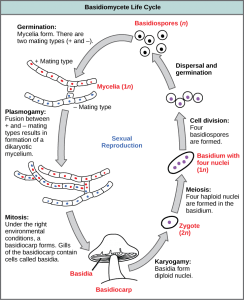Subkingdom: Mycota
Division: Eumycota
Sub-division: Basidomycotina
- G.C. Ainsworth’s system of classification includes Basidomycotina which is a subdivision under Eumycota
- This is also known as Club Fungi
- This is also non-motile fungi.
- These group of fungi are known to be true fungi.
- Major edible fungi belong to this Phylum
- It is a large group of fungi having around 30000 species.
- They include mushrooms and toadstools, bracket fungi, puffballs, earth stars, stinkhorns, false truffles, jelly fungi, earth balls and some less familiar forms.

General Characteristics
- These have septate and multinucleate mycelium while some are yeast-like and others are dimorphic
- They are known as club fungi due to the presence of club-shaped basidium.
- Fruiting bodies are called basidiocarps
- These are found in the tip of the stalks called sterigmata
- Cell wall made up of chitin
- They have well developed filamentous mycelium
- Adjacent cells are separated by dolipore septa
- The transverse septa which divide both monokaryotic and dikaryotic hyphae into segments
contain a central pore which allows cytoplasmic continuity between adjacent segments. The septal pore is surrounded by a barrel-shaped flange of thickened wall material called dolipore
septa which are a characteristic feature of Basidiomycotina - They are found in terrestrial regions but some grow in freshwater or marine habitats.
- They may be saprotrophic and are involved in litter and wood decay.
- The fruit bodies of many mushrooms are edible Ex. Agaricus bisporus, Pleurotus spp, Lentinula edodes.
- They possess both sexual and asexual reproduction
- Basidiomycota are known to be related to Ascomycota
Classification
- Teliomycetes
- Hymenomycetes
- Gastromycetes
Reproduction
It undergoes vegetative, asexual and sexual reproduction.
Vegetative Reproduction
- Fragmentation
- Budding
Asexual Reproduction
- Conidia formation– It may develop on monokaryotic or dikaryotic mycelia. In rusts, smuts, etc
- Oidia- It may develop on monokaryotic and dikaryotic mycelia
- Clamydospores- They are formed terminally on aerial branched conidiophores which develop from a mycelium lacking clamp connections.
Sexual Reproduction
- It also involves plasmogamy, karyogamy and meiosis.
- Plasmodium forms the dikaryotic mycelium
- Karyogamy and meiosis leads to the formation of basidiospores
Basidiospores
- These are small, haploid, thin-walled and uninucleate cells produced exogenously on the basidium.
- The number of basidiospores produced by a single basidiocarp can be extremely high.
- They are transported by the wind current, insect or rain etc. and later start germinating.
- These are considered sexual spores as they combine the genetic material from both the strains.
Life Cycle
- It includes alternation of generations
- It takes place in the fruiting body in basidia
- The basidia are formed by plasmogamy
- Many of these fungi in this group have a dimorphic life cycle.
- The life cycle continues in 3 phases-

- Plasmogamy- The haploid donor cell nucleus penetrates cytoplasm of the recipient cell
- Karyogamy- Two strains of nuclei fuse together
- Meiosis- The diploid nucleus produces haploid nuclei
Economic Importance
- Most edible fungi fall in this group
- Many of these fungi are also pathogenic in nature
- Sporobolomyces roseus basidiospores is a cause for respiratory allergens which is found on moribund leaf surfaces.
- Another is Cryptococcus neoformans, which grows commonly on old “weathered” bird droppings, and which can cause a fatal systemic infection of immunocompromised people. Its air-borne basidiospores initiate infection via the lungs, leading to the disease termed cryptococcosis.
Reference
Introduction to Fungi, Third Editionhttps://www.sciencedirect.com/topics/biochemistry-genetics-and-molecular-biology/basidiomycetes
https://courses.lumenlearning.com/suny-biology2xmaster/chapter/classification-of-fungi/
http://archive.bio.ed.ac.uk/jdeacon/microbes/basidio.htm
More Topics To Read
